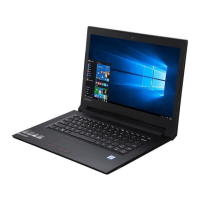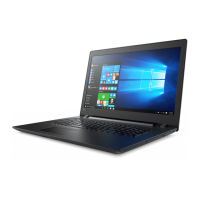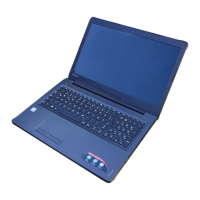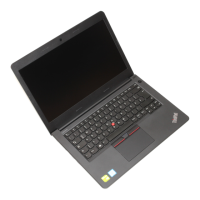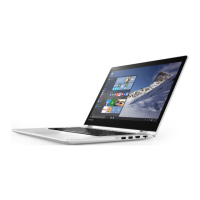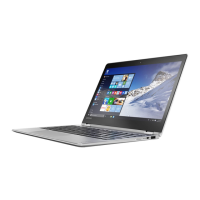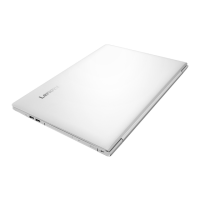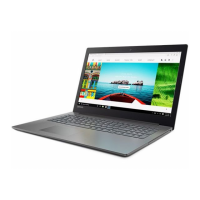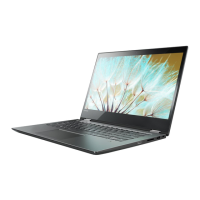Do you have a question about the Lenovo V310 and is the answer not in the manual?
Identifies external components visible from the top of the laptop, including camera, microphone, and display.
Details the keyboard layout, the numeric keypad, and function key combinations for the laptop.
Lists keyboard shortcuts (hotkeys) for quickly accessing system settings and features.
Describes how to change the default hotkey behavior via BIOS settings for enhanced functionality.
Identifies ports and indicators located on the left side of the laptop for connectivity.
Provides instructions on how to connect external USB devices to the computer's ports.
Guide to establishing a wired internet connection using a network cable to the computer.
Identifies ports and components located on the right side of the laptop for various connections.
Details the components and indicators located on the front of the laptop, such as card slots.
Explains compatible memory card types and provides instructions for insertion and removal.
Identifies components and features located on the bottom of the laptop, including ventilation.
Steps for initial setup and configuration of the operating system upon first use.
Explains how to shut down, sleep, or hibernate the computer to conserve power.
Instructions for enabling wireless functions and connecting to Wi-Fi networks.
Guidance on accessing Windows Help and support files for user assistance.
Overview of the Windows 10 start menu and basic interface elements for navigation.
Explains how to access and use Windows settings for basic tasks and system configuration.
Instructions on customizing the Windows start menu by pinning favorite applications.
Details on using Task view and managing virtual desktops within the Windows 10 environment.
Information on using the Get Started app to learn about new features of Windows 10.
Steps for creating a system image backup for disaster recovery purposes.
Instructions for restoring the system partition to its original state or a previous backup point.
Answers to common questions related to computer usage, software, and hardware.
Guidance on locating safety precautions, hardware specifications, and warranty details.
Information on where to find installation discs or download necessary drivers for the computer.
Troubleshooting for backup failures and issues with restoring the system partition.
Explains the BIOS setup utility and provides instructions on how to access and use it.
Information on how to contact customer support for technical assistance.
General troubleshooting steps for common computer problems and system responsiveness.
Solutions for issues such as blank screens, unreadable text, or distorted display output.
Procedures for handling forgotten BIOS or system passwords and related security measures.
Troubleshooting steps for issues related to sleep mode, power management, and computer responsiveness.
Solutions for screen-related issues like unreadable text or distorted images on the display.
Troubleshooting steps for audio issues, such as no sound from speakers or incorrect playback.
Guidance for issues with the battery shutting down unexpectedly or having a short operating time.
Troubleshooting steps for when the hard disk drive is not functioning correctly or is not detected.
Solutions for backup failures or inability to restore the system partition to factory default.
Addresses general issues like the computer not responding or failing to start from a specific device.
Instructions for replacing user-replaceable components like optical drives or batteries.
| Bus type | OPI |
|---|---|
| Stepping | H0 |
| Tjunction | 100 °C |
| Processor cache | 3 MB |
| Processor cores | 2 |
| Processor model | i5-7200U |
| System bus rate | 4 GT/s |
| Processor family | Intel® Core™ i5 |
| Processor socket | BGA 1356 |
| Processor threads | 4 |
| Processor codename | Kaby Lake |
| Configurable TDP-up | 25 W |
| Processor frequency | 2.5 GHz |
| Processor cache type | Smart Cache |
| Configurable TDP-down | 7.5 W |
| Processor lithography | 14 nm |
| Processor manufacturer | Intel |
| PCI Express slots version | 3.0 |
| Processor boost frequency | 3.1 GHz |
| Processor operating modes | 64-bit |
| ECC supported by processor | No |
| PCI Express configurations | 1x2+2x1, 1x4, 2x2, 4x1 |
| Thermal Design Power (TDP) | 15 W |
| Configurable TDP-up frequency | 2.7 GHz |
| Configurable TDP-down frequency | 0.8 GHz |
| Maximum number of PCI Express lanes | 12 |
| On-board graphics card | Yes |
| On-board graphics card ID | 0x5916 |
| Discrete graphics card model | Not available |
| On-board graphics card model | Intel® HD Graphics 620 |
| On-board graphics card family | Intel® HD Graphics |
| Maximum on-board graphics card memory | 32 GB |
| On-board graphics card OpenGL version | 4.4 |
| On-board graphics card base frequency | 300 MHz |
| On-board graphics card DirectX version | 12.0 |
| On-board graphics card dynamic frequency (max) | 1000 MHz |
| Form factor | Clamshell |
| Product type | Laptop |
| Product color | Black |
| Housing material | Acrylonitrile butadiene styrene (ABS) |
| Market positioning | Business |
| Pointing device | Touchpad |
| Display diagonal | 15.6 \ |
| Display brightness | 220 cd/m² |
| Display resolution | 1366 x 768 pixels |
| Native aspect ratio | 16:9 |
| Docking connector | - |
| USB 2.0 ports quantity | 1 |
| USB 3.2 Gen 2 (3.1 Gen 2) Type-A ports quantity | 0 |
| HDD size | 2.5 \ |
| HDD speed | 5400 RPM |
| HDD capacity | 1000 GB |
| HDD interface | SATA III |
| Storage media | HDD |
| Optical drive type | DVD±RW |
| Compatible memory cards | MMC, SD, SDHC, SDXC |
| Battery capacity | 32 Wh |
| Battery life (max) | 6 h |
| WWAN | Not installed |
| Antenna type | 1x1 |
| Wi-Fi standards | 802.11a, Wi-Fi 5 (802.11ac), 802.11b, 802.11g, Wi-Fi 4 (802.11n) |
| Bluetooth version | 4.1 |
| Top Wi-Fi standard | Wi-Fi 5 (802.11ac) |
| Ethernet LAN data rates | 10, 100, 1000 Mbit/s |
| Password protection type | HDD, Power on, Supervisor |
| Speaker power | 1.5 W |
| Memory slots | 1x SO-DIMM |
| Internal memory | 8 GB |
| Memory clock speed | 2133 MHz |
| Memory form factor | On-board + SO-DIMM |
| Internal memory type | DDR4-SDRAM |
| Maximum internal memory | 16 GB |
| Memory layout (slots x size) | 1 x 4 GB |
| Sustainability certificates | RoHS, ENERGY STAR |
| Front camera signal format | 720p |
| AC adapter power | 45 W |
| AC adapter frequency | 50 - 60 Hz |
| AC adapter input voltage | 100 - 240 V |
| Operating system installed | FreeDOS |
| Processor code | SR2ZU |
| Processor ARK ID | 95443 |
| Processor package size | 42 x 24 mm |
| Supported instruction sets | AVX 2.0, SSE4.1, SSE4.2 |
| Intel Identity Protection Technology version | 1.00 |
| Intel Stable Image Platform Program (SIPP) version | 0.00 |
| Depth | 262 mm |
|---|---|
| Width | 380 mm |
| Height | 22.9 mm |
| Weight | 1850 g |
